We consider the generating function for increasingly labelled trees. By generalizing the proof through symbolic method, we are able to study various statistics regarding binary increasing trees with respect to height restrictions. We then apply our approach to special colorings of increasing trees in order to obtain their generating functions and, from there, derive the counting sequence for
The enumeration of trees has long been an interesting topic of study.
It is a natural progression to assign some sort of labeling to the
vertices of these trees, and from that, we have increasingly labeled
trees. Formally speaking, an increasing tree is a tree which is
labeled in a strictly increasing manner (where every vertex has a
smaller label than any of its descendants) by
This concept can also be expanded to trees with no restrictions on their down degrees (as opposed to the binary case, where all down degrees are 2 or 0), which are called recursive trees. Figure 1 shows an example. Recursive and random recursive trees have been extensively studied by Meir and Moon [5,6] and also by Szymański [10].
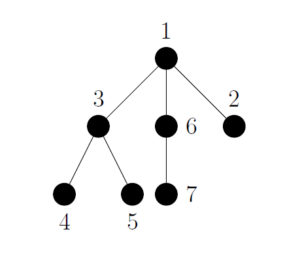
Interesting enumeration questions arise from these concepts. In the
case of the recursive trees, it is well known that it is enumerated by
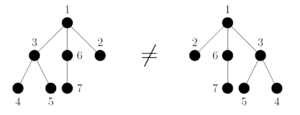
Based on the work of Bergeron, Flajolet, and Salvy in their landmark paper [1], one may consider various enumeration problems of colored increasingly labeled trees whose vertices have a number of color options based on their down degrees (the number of children of a vertex). In preparation for this, we first introduce some basic definitions and previous work on combinatorial classes and their generating functions in Section 2.
These essential ideas allow us to use generating functions to study increasing trees with restricted heights and study various interesting statistics in Section 3.
From there, we move on to consider colored increasing binary trees.
Some of their counting sequences appear to coincide with some previously
known sequences, with connections to a number of interesting concepts,
including: alternating permutations, Euler and Bernoulli polynomials,
zigzag numbers, trigonometric functions, Fourier transform of a square
wave, quantum algebras, integrals over and in n-dimensional hypercubes
and over Green functions [4,9], and generalized tangent numbers [8]. The counting sequences are
justified through both generating functions and combinatorial arguments,
and generalized for
We then shift our attention to colored recursive trees in Section 5, where similar analysis through
generating functions is shown, followed by combinatorial arguments. In
particular, the enumeration of
Lastly, in Section 2, we briefly discuss the counting sequences introduced from this work. Some of the data is shown in the appendix.
The general definitions and techniques follow those developed in
[1] and [3]. A combinatorial
class is a finite set along with a size function where every object
has a size that is a non-negative integer and the number of objects of
any size is finite. The generating function of a combinatorial class
Plane:
Non-plane:
The following theorem was given in [1]. Here, we provide details of the proof
using symbolic notations developed in [3]. This approach is generalized to present
some of the observations shown in this paper. With the given degree
functions, the increasing trees are described by the combinatorial class
Proof. It is defined by Flajolet and Sedgewick in [3] that
We now apply this to
As an example, applying Theorem 2.2
to the degree function
We may apply the developed approach to increasing trees with
restricted heights. We will denote the class of all increasing trees
with height less than or equla to
As an example, Proposition 3.1 can be used to calculate the generating function for plane binary increasing trees whose height is less than or equal to three.
In general, we may apply Proposition 3.1 to obtain various
statistics related to binary increasing trees. In Figure 3, we plot the probability of trees of a
given order has restricted height
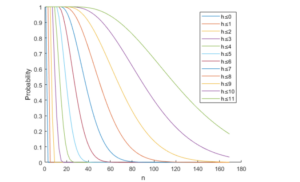
We may also use our data to identify three thresholds where the
percentage of non-plane binary increasing trees of restricted height
passes or achieves
| height | order | probability |
|
|
|
|
|
|
|
|
|
|
|
|
|
|
|
|
|
|
|
|
|
|
|
|
|
|
|
|
|
|
|
|
|
|
|
|
|
|
|
|
|
|
|
|
|
|
|
|
|
|
|
|
|
|
|
|
|
|
|
|
|
|
|
|
|
|
|
|
|
|
|
|
Given the order of the increasing binary trees, we may also study the
distribution of them according to different values. As examples, we
consider trees of order 31, 61, and 121 respectively in Figure 4. Note that the final
column represents trees with height

Lastly, in Figure 5, we present the probability of a
non-plane binary increasing tree of order
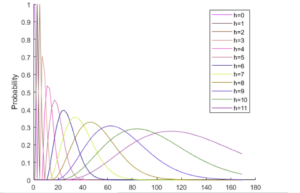
We move on to study general theories and specific combinatorial argument related to colored increasing trees.
First of all, We say an increasing binary tree is
Proof. From Definition 2.1
we obtain the degree function
By Theorem 2.2, we have
Similarly, for non-plane trees we have the following.
Proof. We obtain the degree function in a similar way,
The proof proceeds from Theorem 2.2 giving us,
From the above proofs, it is easy to see that the generating
functions for
Proof. We start with the simple case of
Similarly, in the more general case: in the plane tree we have
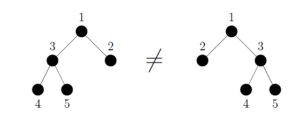
However, in the case of the non-plane binary tree we see that same can not be said which we illustrate in Figure 7.
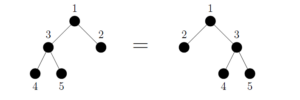
If we instead color the non-plane binary tree though we see that they are no longer equivalent as in Figure 8.
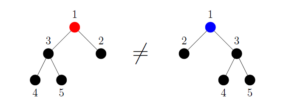
This allows us to map them like in Figure 9 and Figure 10.

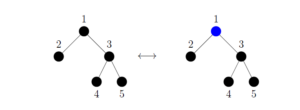
We can take this a step further, while no generating functions can be
explicitly shown for
We now move on to consider general trees with all possible down
degrees allowed. First, we define a
For
Proof. It is clear that degree function given by the
The rest follows from the fact that this is the same degree function
as that of the (non-colored) plane recursive trees.
It is not difficult to apply combinatorial arguments similar to the
last section to justify that the plane recursive trees and
Proof. Starting from the set of non-plane trees we can
generate the plane trees by multiplying by the number of ways in which
we can arrange the branches of each vertex. This is the same as
multiplying by
On the other hand, this is the same to let each vertex in the
non-plane tree with down degree
First we consider the case
Letting
This generating function coincides with that of the sequence A008544
in the Online Encyclopedia of Integer Sequences, where simple
application of the general binomial coefficients yields
Proof. Let
In order to consider all possible cases, we must sum
Thus,
The above argument is illustrated in Figure 11.
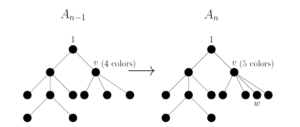
Should one apply similar generating functions and/or combinatorial
arguments to
Let
Indeed, if the number of color choices for each vertex is multiplied
by a fixed value
Applying the symbolic approach, we studied the generating functions corresponding to various classes of colored increasingly labelled trees. This approach allows us to study various statistics related to such trees with restricted heights, as well as colored analogues. Both computational data and combinatorial observations are presented.
1970-2025 CP (Manitoba, Canada) unless otherwise stated.